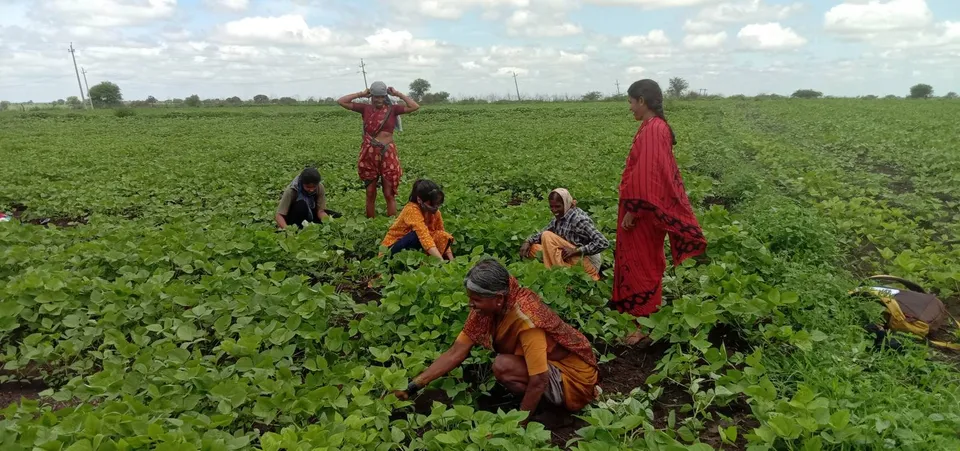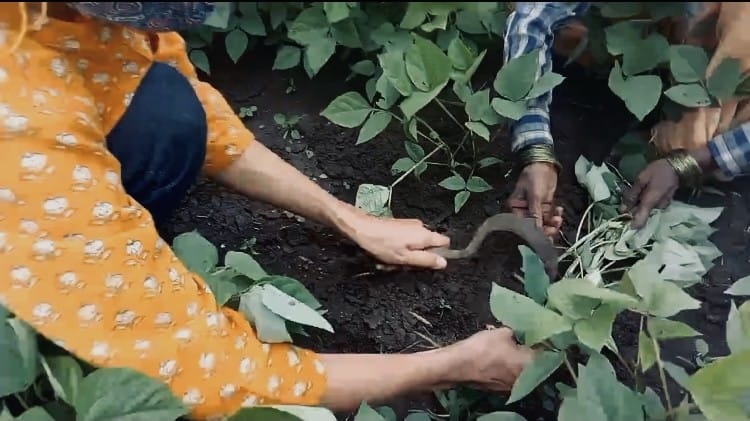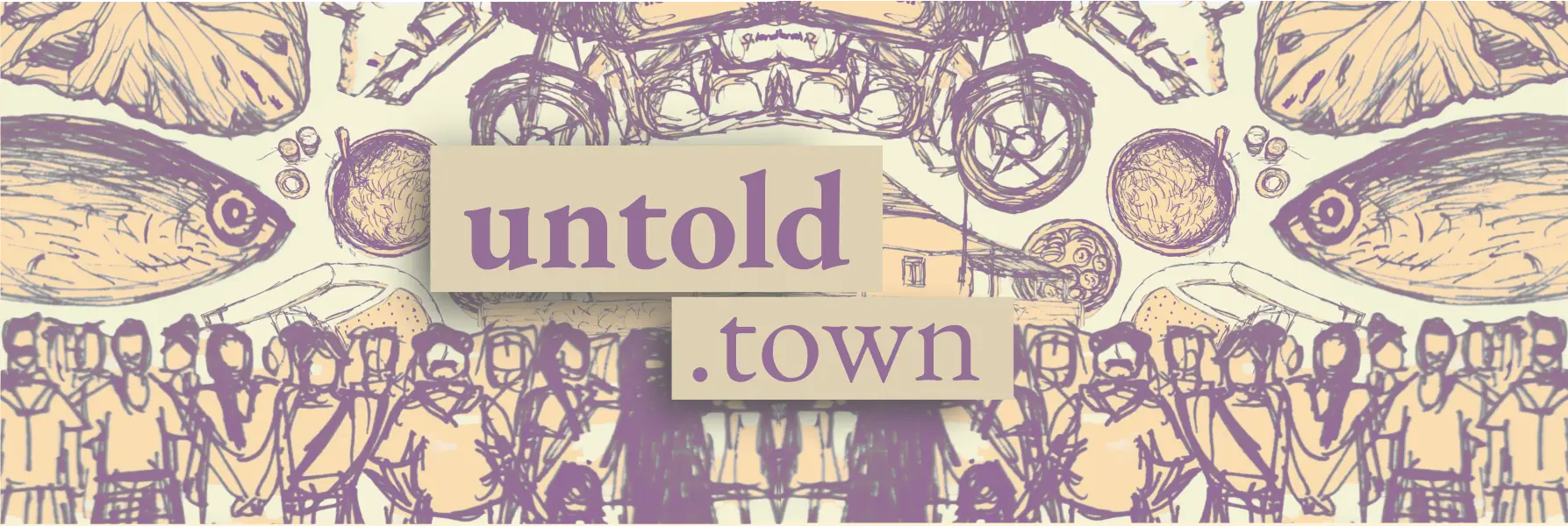'Shaddi Kaleyuvudu' as a way to engage with women farmers

As we rode our scooters through Bidar’s villages in July of 2021, we saw farms everywhere covered in saplings of crops like Togri, Hesaru, and Jowar, planted maybe 15 or 20 days earlier. On most of these farms, groups of women were digging up the soil with khurpis in a process of weed removal called shaddi kaleyuvudu, usually done 2-3 times in each crop cycle.
We went to villages including Sirsi, Gadgi, Aliabad, Chitta and Yakatpur as part of our first ‘field visit’ to begin laying the foundations for the CRC. For the first few days we had been meeting with people who either owned or worked on these farms, who took time out to walk us around their fields, point out crops, answer our questions and share their perspectives. The farmers and farm workers we had spoken to at that point were largely men – occasionally women relatives or neighbours joined in, but conversations had tended to stay anchored by the men.

In these early stages, we hoped to envision and establish the role of the Climate Resource Center alongside the communities it was built around. We were also navigating our own presence on the ‘field’, as ‘researchers’ or ‘designers’ with preconceived ideas and lived experiences so different from the people we were meeting, shaping our interest in understanding how Bidar’s farming communities articulate, experience, and respond to the changing climate and all that it brings.
We decided to spend the next few days specifically meeting with women farmers. We soon realised that in the labour-intensive early days of the Kharif season, the only way to strike up these conversations, or at least begin a process of introductions, would be to meet them while they worked. We arrived one early morning in Dhupadmahagaon, and as we walked from the village to the fields, we found ourselves amongst dozens of women who were heading to work. One of them, Kri, asked us whether we were sarkari employees there to talk about new government schemes. While we tried to explain why we were actually there, two of us arrived together with her at the field she was going to spend the day working in. A group of four other women were already there waiting for her.
We had planned to just introduce ourselves and be open to ending conversations quickly if they did not have much time, hoping to go back another day and talk more. Even though these were intended as unstructured conversations, we often found ourselves beginning with factual questions – talking to people about what weeds they were removing or what crops they were sowing, how the conditions of rain or soil were this season, how long the crop cycle would last.
They showed us how they uproot Benneyalli, Hooligonda and Ilchabatkivi – some of the most frequently found, and troublesome, weeds in these landscapes – moving in rows, digging them at the base, and collecting small piles every few feet. I asked if I could try, and found the process rewarding, gathering a few such piles, but within a few minutes my wrist was hurting. As we were using their khurpis they couldn’t work simultaneously, so two of the women sat back and watched us, digging out smaller weeds with their hands every now and then as they talked.
Participating for a few minutes in the process of shaddi kaleyuvudu immediately gave us a sense of how laborious it was. It also broke the ‘ice’ between us, as the group of farmers watched our slow, fumbling attempts and corrected our technique. Digging into the soil alongside these women, we were briefly wrapped up together in the muddy spaces of ‘everyday knowledge practice’. Shaddi kaleyuvudu – one of the many farming activities carried out almost entirely by women's labour – was a space where agricultural production was made possible, where knowledge practices were iterated and established, friendships were nurtured, and labour was shared. In the context of action-research, the act of sharing in that labour allowed us to be welcomed into that space for that short time.
They typically eat in the morning, pack their lunches and set out to the field, where they stay until around 5pm, and then head back home and cook dinner for the family – “who else will do it?”. We asked whether they were married, where their husbands were while they were here. Some of them laughed, Ka pointed a thumb to her mouth – “they drink, and then they sleep”. They explained to us how the women in their village manage all the tasks involved in sowing, weeding, fertilizing, and harvesting. With weeding, the women sometimes work on neighboring fields and earn Rs. 200-300 a day, or share the labour by working collectively on each of their farms one by one. Kri had lost her husband a few years ago, and she runs her farm by herself. However, when the harvest has been bundled up for sale, it is her young son who must go to the market to fetch a rate for it – as it is expected for men to take up this part of the work. She explains that when she goes into the market herself, traders do not want to do business with her.
While women are recognised as the backbone of agrarian labour, the farmers we had met, heard about, or read about in many existing reports about creatively adapting change were all men. How much of this creativity – through new or old and revived knowledge practices – is driven by women? What role do non-landowning farm workers play in identifying, articulating, or devising responses to changing agrarian or climatic conditions? What role do such gendered and caste-based situated knowledge practices play in shaping Bidar’s response to agrarian and climate change?
After a few hours, we got up to leave, saying we would come back the next day to meet them again, and Kri offered – “since you came to visit us in our farms, we would also like to come to your office for a visit”.
Our emphasis on ‘situated knowledge’ extends beyond the everyday knowledge practices of farming communities facing a changing climate. It extends to our own role, and the structures based on which external researchers ‘produce’ credible knowledge about the contexts they claim to study (Haraway, 1988). The Climate Resource Center is envisioned as a long-term effort – a space where local knowledge practices are collected, documented, and shared with other farming communities in and around Bidar. It is situated within a network of people and projects that together, emphasize processes of co-learning and community-led research. V’s offer to visit us in our place of work next time was in line with some of my own reflections, or questions, about what constitutes co-learning. How do we build relationships on the ‘field’ that go beyond serving a purpose that is already decided and thus limited? It is important that the Center can be continually molded by the changing interests, questions, curiosities and needs of people such as V. The work of understanding climate change is located within larger contexts of resource extraction shaped by powerful agendas and people. However, the study of climate change, particularly how it is experienced by communities on the margins – has itself fallen into extractivist approaches where knowledge and ideas are collected and removed from their situated contexts and producers. How would the Climate Resource Center – and us, as part of it – enable and embody a community-led approach to studying place-based knowledge practices in Bidar and recognise its potential as “an ethical and political practice of world-making”? (Klenk et al, 2017).
The same evening, walking towards where our scooters were parked in Bajapally, we met two women who were nearing the end of a long day of work. Here, we put our recently acquired training to use, using their khurpis to dig a few weeds out of the soil as they sat back and listened to our questions. Ri and Thi had married into a family where the original landowners had three sons, and instead of dividing their land into sections, the family stayed together and lived off the land as a single unit. S explained this was an uncommon arrangement, and as far as she knew they were they only such family in the villages around the area. Their father-in-law was the head of the household and made all the decisions regarding how the farm and their home were to be managed, how the labour was to be divided.
In Bidar, there are predominantly two kinds of soil – red/lateritic soil and black soil, and the crops that are grown on each can be very different. Our experience of learning about shaddi kaleyuvudu and the women who do it took us to both kinds of fields. While digging the red soil in Kri’s farm had been a laborious process, the black soil in Ri and Thi’s farm was immensely harder to dig. It was also filled with rocky patches, which made digging weeds out more challenging, the roots would embed deeper, and the khurpi would dig out only little rocks. In such soil, removing weeds from even a very small patch of land takes a long time, progress is slow and painful.

The first question we asked Ri was – how much area they had covered that day? She responded immediately saying “very little, my husband is going to hit me when he finds out this is all we did today”. If it rains this week, the weeds will almost immediately return.
After she said that, how and why would we have continued to discuss types of soil or the ways in which the changing climate affected their work? While our approach was built recognising the different and interconnected experiences between everyday life at home and in the field, or between one person and the next, sharing space and conversation are matters of immense responsibility, and this extends far beyond that of research questions or community-led approaches. What happens when the most vivid lived experience of shaddi kaleyuvudu is not necessarily the hours of labour or the nature of soil or the increase in pests, but rather the fear of retaliation from the men at home if they decide the work done was insufficient? Emerging criticisms of dominant approaches to the study of climate change have pointed out how it continues to be discussed in uniformly scientific, managerial ways, “rendering the issue as both universal and distant, instead of differentiated and embodied” (Bee et al, 2015). Feminist research has always talked about how differentiated everyday experiences and intimate spaces actively shape global processes of production and adaptation. The Climate Resource Center, us, our presence in Dhupadmahagaon, could not exist in isolation from the complex layers that make up peoples’ environments, the power dynamics ever-present between us, and how they are all experienced.
Ri and Thi had come to their field with their family’s cow, who was tied to a pole near the corner of their farm and slowly grazing on the grass, and they talked quietly between themselves about the animal. S told us they use the cow’s dung as manure on their field. In what other ways did they source manure? She began by explaining that they refuse to use goat dung on their fields, and will only use that of cows, buffaloes or sheep. She went on to say that goats are reared and cared for only by communities from marginalized castes in the village – “they will even eat the goats ... but we don’t even use their milk or gobar”. Their family are Marathas, who she says only rear cows or buffaloes, so “even looking at a goat makes (her) nauseous”. Soon after, they began to collect the small piles of dug up weeds into a larger pile, and head home for the day.
Understanding the effects of a changing climate on the lives and practices of farming communities is embedded into situated and interconnected dynamics. Our conversations with these farmers were initiated with the practice of shaddi kaleyuvudu, and through it, so much more. Not only are the experiences of Bidar’s farmers in the face of climate change different from those of farming communities elsewhere, even within a single village or cluster of farms, the everyday knowledge practices that sustain agricultural production, and guide how climate change is understood and adapted to can vary. To build a collective knowledge base about climate change requires understanding so many interconnected dynamics – agrarian policy, land ownership, relationships of labour and intimacy on the field and in homes, new pests and pesticides, social norms. To ask a farmer about how climate change shapes their everyday life can involve conversations about the timelines determined by changing environmental patterns and the ones upheld by patriarchal violence, the resources chosen because of their role in managing weeds or diseases and the ones chosen to maintain human and nonhuman caste hierarchies (Kawade, 2023), the knowledge that is produced and disseminated through imbalanced power relations and the kind that is produced and creatively adapted through everyday knowledge practices. These interconnected layers are why the Climate Resource Center is proposed as a community-led, action-research project.
